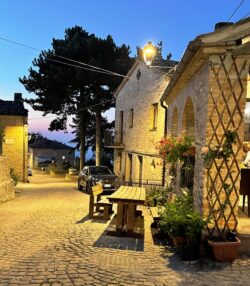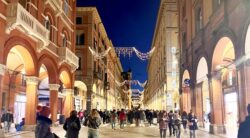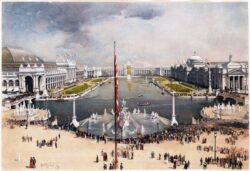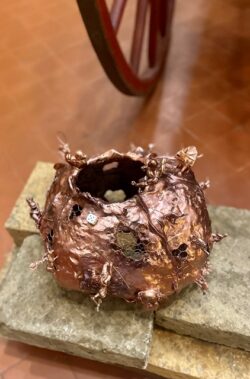Read Time: 4 Minutes Subscribe & Share
Urban Occupations
 Being a city girl has some advantages. While I may not have at hand a beautiful view of a stunning landscape and the accompanying clean air – all quite laudable attributes – I do have the advantages of a constantly changing scene of events and people, with loads of diverse art forms at my fingertips. Although shops and
Being a city girl has some advantages. While I may not have at hand a beautiful view of a stunning landscape and the accompanying clean air – all quite laudable attributes – I do have the advantages of a constantly changing scene of events and people, with loads of diverse art forms at my fingertips. Although shops and restaurants might not feed your mind and soul, they have other appealing qualities. This brought to my mind thoughts about the proliferation of trade fairs in urban centers,(Bologna has many) which serve to introduce not only trends in fashion and furnishings, but also in food, wine and art.
restaurants might not feed your mind and soul, they have other appealing qualities. This brought to my mind thoughts about the proliferation of trade fairs in urban centers,(Bologna has many) which serve to introduce not only trends in fashion and furnishings, but also in food, wine and art.
A European Institution
 Records of trade fairs can be traced to ancient Greece and Rome, and it is in Europe that they become more formalized during the Middle Ages. Traders in European countries held markets on fixed dates in both towns and cities, and other events would be coordinated around these “Mart” fairs. It was, however, the Industrial Revolution that gave the concept of trade fairs a much broader scope. According to the source of almost all my knowledge, Wikipedia, the capstone and introduction of industrial design most likely was in 1851, when Prince Albert organized “The Great Exhibition of the Works of Industry of All Nations” in London. This extravaganza showcased the latest innovations in science, technology, and industry. The Crystal Palace, built by a greenhouse designer, housed over 17,000 exhibitors. The event attracted over six million visitors and set the standard for future international
Records of trade fairs can be traced to ancient Greece and Rome, and it is in Europe that they become more formalized during the Middle Ages. Traders in European countries held markets on fixed dates in both towns and cities, and other events would be coordinated around these “Mart” fairs. It was, however, the Industrial Revolution that gave the concept of trade fairs a much broader scope. According to the source of almost all my knowledge, Wikipedia, the capstone and introduction of industrial design most likely was in 1851, when Prince Albert organized “The Great Exhibition of the Works of Industry of All Nations” in London. This extravaganza showcased the latest innovations in science, technology, and industry. The Crystal Palace, built by a greenhouse designer, housed over 17,000 exhibitors. The event attracted over six million visitors and set the standard for future international exhibitions.
exhibitions.
It was not until 1893 that America had its first trade fair in Chicago, similar to those in Europe. My grandfather attended this fair and told me stories about the magnificent displays and innovations, such as elevators, the first voice recording, Crackerjacks, diet sodas and Juicy Fruit Gum. On the artistic side, the Japanese Pavilion and its garden influenced the later architecture of a very young Frank Lloyd Wright when he attended it. Jackson Park, designed by Frederick Law Olmsted specifically for this trade fair, and the Japanese Pavilion and surrounding garden are both gorgeous remnants of the exhibition — pieces of American history that you can visit today.
Twist On A Trade Fair
I did not realize the existence of Bologna’s internationally prestigious ArteFiera until my daughter’s sister in law, an art historian, arrived from Rome to explore all its aspects. ArteFiera 2024 celebrated the 50th year of what started as a trade fair for galleries, art publishers and qualifying individual artists. In 1974, the organizers of the fair decided to include a small space for contemporary artists as sort of a point of interest. There were ten featured. This small exhibition’s surprising popularity within ArteFiera exploded into 200 exhibitors by the following year.
Its official sites for exhibitions have expanded to include some emerging artists, solo shows, photography, and new research into modern and contemporary art (a niggling definition is needed here on the difference between the two: according to Google Arts and Culture, most art historians and critics put the beginning of modern art in the West at around the 1860s, continuing up to the 1960s, whereas contemporary art means art made in the present day).
 The invitation of the ArteFiera includes a kaleidoscope of local and not-so-local artists who display or perform their works in somewhat alternative galleries throughout the city. Some are in small museums or churches or even the small palazzi that are not normally open to the public, which makes for an engaging tour of exploration of interior spaces that might otherwise escape your notice. I followed Paola Pallotta – the art historian – and a friend
The invitation of the ArteFiera includes a kaleidoscope of local and not-so-local artists who display or perform their works in somewhat alternative galleries throughout the city. Some are in small museums or churches or even the small palazzi that are not normally open to the public, which makes for an engaging tour of exploration of interior spaces that might otherwise escape your notice. I followed Paola Pallotta – the art historian – and a friend who is a knowledgeable guide in Bologna to some of these different sites and the artists that had featured their works within. My personal favorites were the Oratorio di San Filippo Neri on Via Manzoni, which was heavily damaged by Allied bombardment in world War II. While the art installation did not hold my interest, the unusual approach taken by the restoration committee was simply stunning. A second installation in a museum of decorative arts was almost kitschy in its fantastical recreation of nests (particularly since my grandsons are surrounded by the flotsam and jetsam of numerous plastic soldiers, Lego – Star Wars installations, and other unrelated fantasy figures).
who is a knowledgeable guide in Bologna to some of these different sites and the artists that had featured their works within. My personal favorites were the Oratorio di San Filippo Neri on Via Manzoni, which was heavily damaged by Allied bombardment in world War II. While the art installation did not hold my interest, the unusual approach taken by the restoration committee was simply stunning. A second installation in a museum of decorative arts was almost kitschy in its fantastical recreation of nests (particularly since my grandsons are surrounded by the flotsam and jetsam of numerous plastic soldiers, Lego – Star Wars installations, and other unrelated fantasy figures).
Let’s Eat
 But a City Girl has got to eat, and one of the delicious aspects of a any cultural tour in Bologna is that you are not reduced to fast food chains or eateries run by “food groups” that seem to have invaded urban spaces in the US. And that doesn’t sentence you to a formal restaurant. If you are here and want something a bit different than tagliatelle al ragu and tortellini, try Scampo on Via Galliera, where you pick your seafood and they cook it for you to eat either in or outside. Or Pescheria La Crevette (where we had a wonderful lunch) which offers delicious seafood spiedini, and other
But a City Girl has got to eat, and one of the delicious aspects of a any cultural tour in Bologna is that you are not reduced to fast food chains or eateries run by “food groups” that seem to have invaded urban spaces in the US. And that doesn’t sentence you to a formal restaurant. If you are here and want something a bit different than tagliatelle al ragu and tortellini, try Scampo on Via Galliera, where you pick your seafood and they cook it for you to eat either in or outside. Or Pescheria La Crevette (where we had a wonderful lunch) which offers delicious seafood spiedini, and other fish specialties cooked on the spot. Or the contemporary take on pizza by the slice (a Roman tradition) offered by PizzArtist or Pistamentuccia. And if you want to taste a Bolognese take on the American art form of Barbecue you must try Low and Slow, It pushes the boundaries of one of our most rigidly held and sacred food traditions, while staying true to BBQ’s founding tenets.
fish specialties cooked on the spot. Or the contemporary take on pizza by the slice (a Roman tradition) offered by PizzArtist or Pistamentuccia. And if you want to taste a Bolognese take on the American art form of Barbecue you must try Low and Slow, It pushes the boundaries of one of our most rigidly held and sacred food traditions, while staying true to BBQ’s founding tenets.

Kitchen Detail shares under the radar recipes, explores the art of cooking, the stories behind food, and the tools that bring it all together, while uncovering the social, political, and environmental truths that shape our culinary world.




This sounds a bit like Spoleto Festival and it’s local version Piccolo Spoleto in Charleston. I had a great time interning there while in college. The Festival had the big names or productions and the local artists had some amazing performances at the same time throughout the city – some free or very low cost. There are advantages to urban living too. The food is good enough reason to go to Bologna but maybe I should time it with a festival or trade fair or “mart”.
Jennifer,
You’re right, it does have some of the same vibe. I had always wanted to go to the one in Charleston, particularly for the dance. Let me know if you come to Bologna!
Nancy
Thank you so much Nancy, and proud helping you to discover ArteFiera!